I had blogged about the M 16 and my experiences with the Rifle and my personal Rifles. you know...before the durn Kayak accidents. Y'all can "Read about it and ordinance dept shafting the development". This was another article that I snagged from "American Rifleman", I have been busy working, but I just took a week off from work to do spring cleaning including getting a big roll on dumpster.

On April 19, 1963, military aide Gen. Chester V. Clifton brought two firearms into the Oval Office to show them to President John F. Kennedy. One was a crossbow intended for use in counterinsurgency operations, and the other was an AR-15, the Colt Model 601. President Kennedy had seen the AR-15 demonstrated the year before and had been directly involved in the gun’s military procurement, so he was well aware of the various innovative aspects of its design. The example JFK held that afternoon in the White House was the product of a lengthy design development evolution that began six years earlier and would eventually produce the most prolific military rifle in the nation’s history.
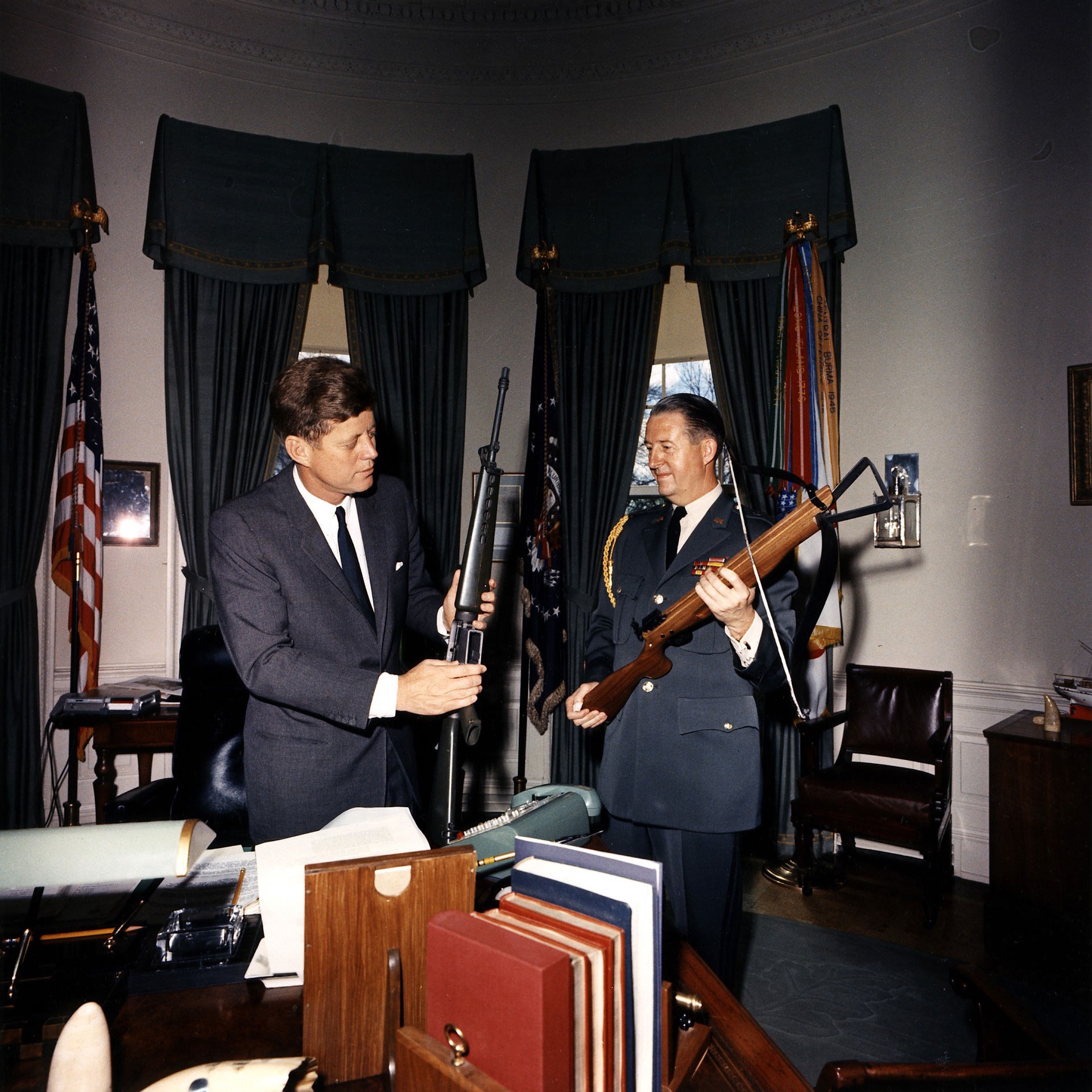 President
John F. Kennedy and Military Aide Gen. Chester V. Clifton examine a
Colt Model 601 rifle and crossbow in the White House’s Oval Office in
April 1963. (ST-C85-1-63)
President
John F. Kennedy and Military Aide Gen. Chester V. Clifton examine a
Colt Model 601 rifle and crossbow in the White House’s Oval Office in
April 1963. (ST-C85-1-63)
When a White House photographer snapped a now-famous image of the meeting, John Kennedy had only 217 days left to live, but the Model 601 on the other hand was just beginning its military service. During the next six decades, the rifle would fight in Vietnam, Grenada, Panama, Iraq and Afghanistan, among other geopolitical hotspots. Its basic design would evolve during those 60 years to ultimately become the M4 carbines and M16A4 rifles that arm our troops today. But it all began with the Model 601, the rifle that President Kennedy personally examined in the Oval Office.
 Right side view of the ArmaLite XAR1501 prototype. Photo courtesy of the Institute for Military Technology
Right side view of the ArmaLite XAR1501 prototype. Photo courtesy of the Institute for Military Technology
Serial production of the Model 601 began in December 1959, and continued through to the summer of 1963. During that time, more than 14,000 of them came off the assembly line. Although the Model 601 was the first AR-15 to be mass-produced, it was not the first AR-15. The design development and evolution that ultimately led to it began in the spring of 1957, when the Continental Army Command (CONARC) expressed an interest in evaluating a rifle chambered for a Small Caliber, High Velocity (SCHV) cartridge. By then, the ArmaLite Division of Fairchild Aircraft Corporation was attempting to find a buyer for a 7.62×51 mm NATO-chambered, select-fire rifle that had been designed by Eugene Stoner and developed under the model designation AR-10.
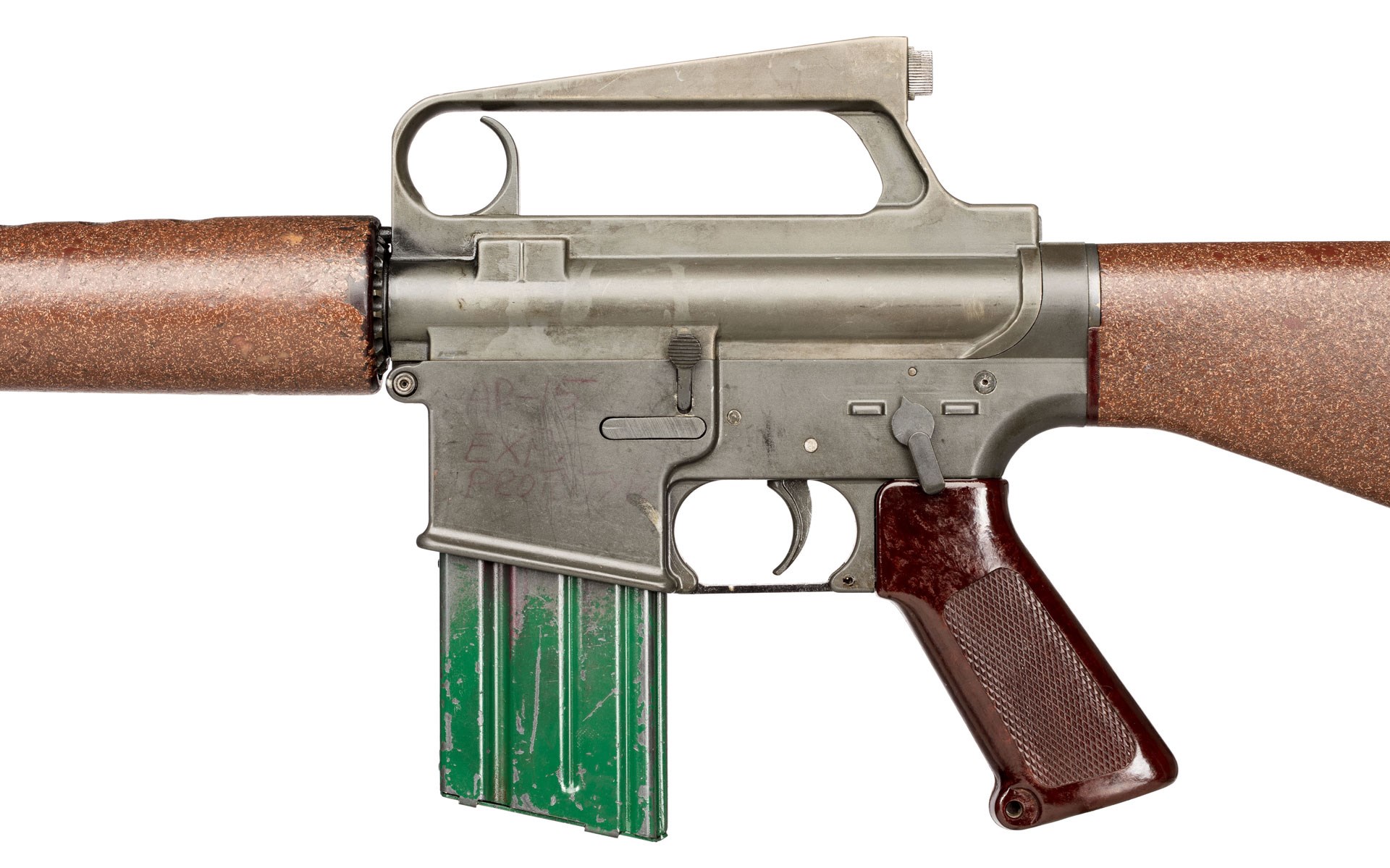 Left side closeup of the receiver of the ArmaLite XAR1501 prototype. Photo courtesy of the Institute for Military Technology
Left side closeup of the receiver of the ArmaLite XAR1501 prototype. Photo courtesy of the Institute for Military Technology
Although it was lightweight, because of the use of plastic and aluminum in its construction, and it offered a number of significant advantages as an infantry rifle, the U.S. Army had just rejected the AR-10 in favor of the M14. Despite this setback, ArmaLite was not ready to throw in the towel, so it continued to look for a customer for the AR-10 while it simultaneously began a process of adapting its design to the type of SCHV cartridge the Army now wanted to test. Two engineers at ArmaLite, Robert Fremont and L. James Sullivan, were therefore assigned the task of scaling-down Stoner’s 7.62 NATO rifle to chamber an existing wildcat cartridge known as .222 Remington.
 Right
side view of ArmaLite prototype AR-15 Serial No. 000001. Note the
buttstock and one-piece forward handguard made from woven fiberglass. Photo courtesy of the Institute for Military Technology
Right
side view of ArmaLite prototype AR-15 Serial No. 000001. Note the
buttstock and one-piece forward handguard made from woven fiberglass. Photo courtesy of the Institute for Military Technology
The prototype that Fremont and Sullivan created generally resembled the AR-10, insofar as it combined a buttstock and forward handguard made from woven fiberglass with an upper and lower receiver made of anodized aluminum. Like the AR-10, a distinctive carry handle was incorporated in the upper-receiver forging that provided protection for an equally distinctive non-reciprocating, trigger-type cocking handle. The rifle used Stoner’s patented direct gas-impingement operating system and multi-lug rotating bolt, a 20" fluted pencil barrel with 1:14" twist rifling, and a detachable box magazine with 25-round capacity. Designated XAR-1501, it was demonstrated for CONARC by Stoner himself in May 1957, with the result that an order for 10 additional test rifles for further evaluation was placed.
 Left side closeup of ArmaLite prototype AR-15 Serial No. 000001. Note the AR-10 trigger type charging handle. Photo courtesy of the Institute for Military Technology
Left side closeup of ArmaLite prototype AR-15 Serial No. 000001. Note the AR-10 trigger type charging handle. Photo courtesy of the Institute for Military Technology
The only problem was that CONARC wanted the new SCHV cartridge’s bullet to penetrate a helmet at 500 yards. Since the .222 Rem. cartridge was not capable of meeting that requirement, Remington modified it by lengthening the case to provide the additional powder capacity needed to generate additional muzzle velocity and achieve the required penetration. A 55-grain bullet and DuPont’s IMR-4475 nitrocellulose smokeless powder brought the package together, and the new cartridge initially received the designation .222 Special. To avoid confusion, though, that designation was ultimately changed to .223 Rem. More changes would soon follow.
 Left-
and right-side view of ArmaLite prototype AR-15 Serial No. 000004. A
601-type upper receiver group from a later phase of the development of
the AR-15 has been paired with the Serial No. 000004 lower despite the
fact that it was first built during an earlier phase. Photo courtesy of the Institute for Military Technology
Left-
and right-side view of ArmaLite prototype AR-15 Serial No. 000004. A
601-type upper receiver group from a later phase of the development of
the AR-15 has been paired with the Serial No. 000004 lower despite the
fact that it was first built during an earlier phase. Photo courtesy of the Institute for Military Technology
In March 1958, ArmaLite delivered the 10 AR-15s in .223 Rem. to Fort Benning, Ga., for test and evaluation. Except for a noticeable change to the rear sight assembly, the addition of a sling swivel to the Bakelite pistol grip and the addition of a bipod mounting bushing affixed to the front sight base, these rifles were anatomically similar to the XAR-1501. Similarities notwithstanding, though, the new cartridge gave them the additional muzzle velocity needed to pass the 500-yard helmet penetration test. In addition to that, these AR-15s exhibited the low malfunction rate of just 6.1 for every 1,000 rounds fired in an early demonstration of the legendary reliability for which the system would ultimately be known.
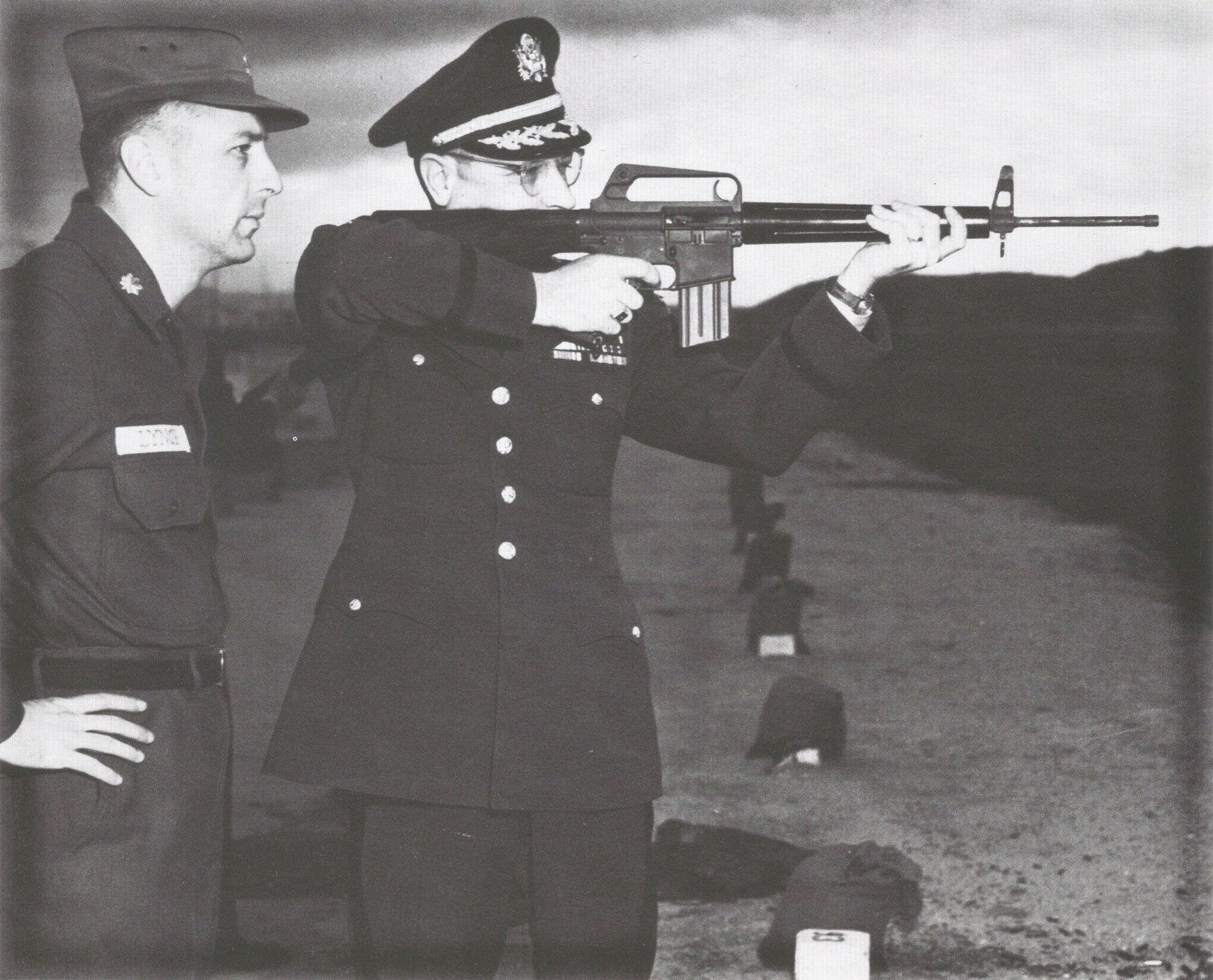 Major
Eugene M. Lynch observes Lt. Col. Robert Vallendorf as he shoulders an
ArmaLite prototype AR-15 (possibly Serial No. 000013) at Fort Benning on
March 31, 1958. The rifle has no flash suppressor, but it is equipped
with the AR-10 trigger type charging handle, one-piece cylindrical
fiberglass handguard, and 25-round capacity magazine. U.S. Army photo
Major
Eugene M. Lynch observes Lt. Col. Robert Vallendorf as he shoulders an
ArmaLite prototype AR-15 (possibly Serial No. 000013) at Fort Benning on
March 31, 1958. The rifle has no flash suppressor, but it is equipped
with the AR-10 trigger type charging handle, one-piece cylindrical
fiberglass handguard, and 25-round capacity magazine. U.S. Army photo
Two months after the tests at Fort Benning, the Infantry Board published a report titled “Evaluation of Small Caliber High Velocity Rifles – ArmaLite (AR-15)” that identified the rifle as a potential replacement for the M14. Everything was not perfect, though, because it was found that the AR-15’s barrel could burst if water intruded into it, and because of that, the board decided that research should continue. Accordingly, the report recommended ordering another eight prototype AR-15s with “minor” modifications for further test and evaluation, and those modifications produced some elements of the AR-15’s anatomy that remain with the firearm to this day.
 Right
side view of a Colt/ArmaLite AR-15 Model 601 cutaway that reveals
details of the rifle’s gas tube, the left handguard’s single heat shield
and the early Edgewater buffer. Photo courtesy of the Institute for Military Technology
Right
side view of a Colt/ArmaLite AR-15 Model 601 cutaway that reveals
details of the rifle’s gas tube, the left handguard’s single heat shield
and the early Edgewater buffer. Photo courtesy of the Institute for Military Technology
First of all, the Army wanted the one-piece conical fiberglass handguard changed to a triangular two-piece design. It also requested a magazine capacity change from 25-rounds to 20-rounds as well as a redesign of the AR-10 trigger type charging handle. In response, ArmaLite introduced a non-reciprocating triangular charging handle positioned at the rear end of the carry handle. To reduce the water sensitivity that had been previously observed, the barrel fluting that had been a part of the first run of prototype rifles was eliminated. This was a change that made the barrel slightly heavier and, therefore, less likely to burst when water intruded into the bore. The selector positions were also changed.
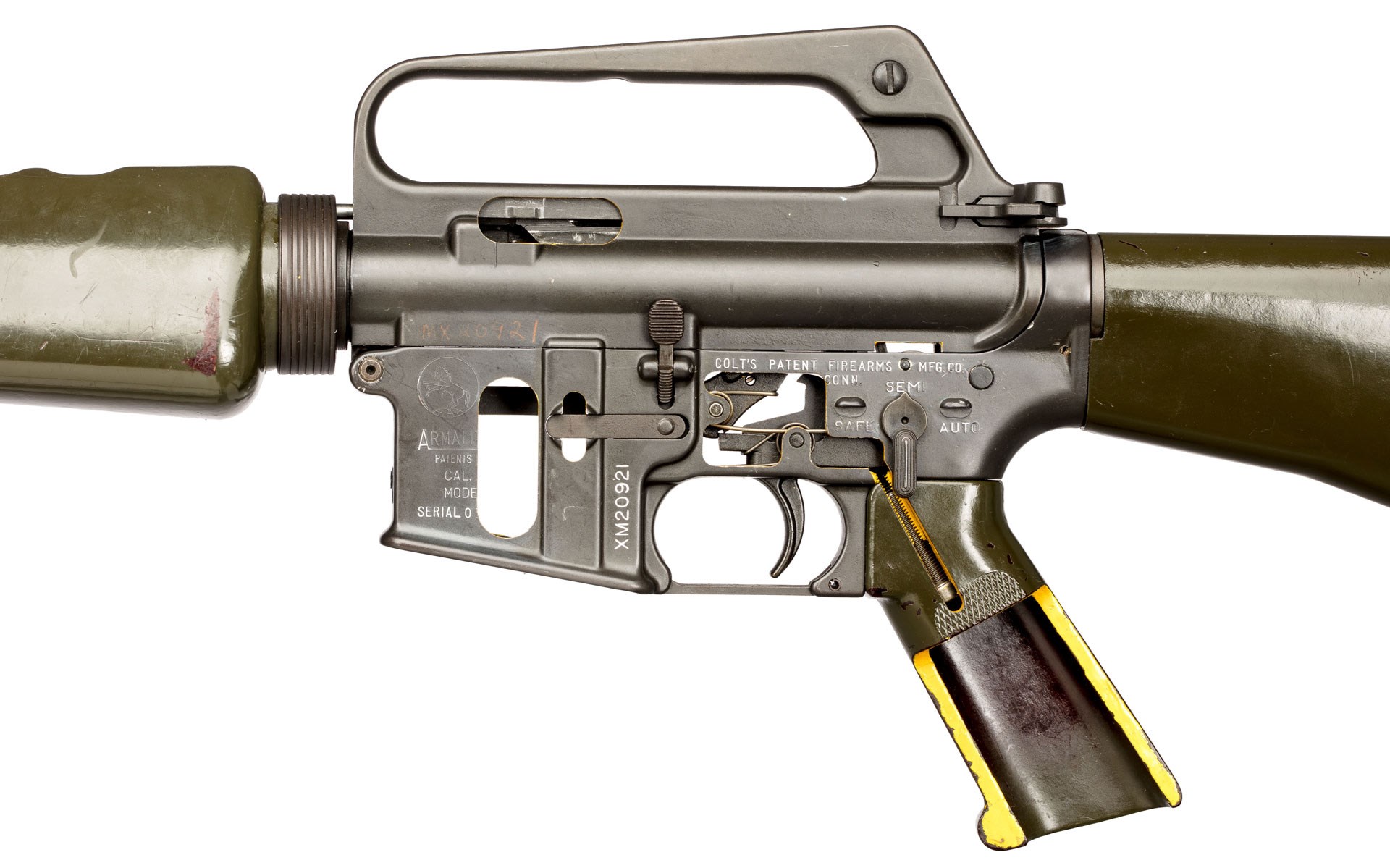 Left
side closeup of a Colt/ArmaLite Model 601 cutaway. The original
601-type triangular charging handle has been replaced by a later
602-type charging handle. Photo courtesy of the Institute for Military Technology
Left
side closeup of a Colt/ArmaLite Model 601 cutaway. The original
601-type triangular charging handle has been replaced by a later
602-type charging handle. Photo courtesy of the Institute for Military Technology
Earlier prototype AR-15s featured selector settings with “AUTO” in the nine o’clock position, “SAFE” at twelve o’clock and “SEMI” at three o’clock. The Army worried that, in this configuration, troops crawling through brush could unintentionally advance the selector from the “SAFE” position to the “AUTO” position. ArmaLite solved the problem with a simple redesign that moved “SAFE” to nine o’clock, “SEMI” to twelve o’clock and “AUTO” to three o’clock. This is also when ArmaLite introduced the aluminum slip ring for retention of the two-piece handguards, as well as a new version of the flash suppressor that could also function as a grenade launcher and a new version of the front-sight base, incorporating a .875" gap between its front and back legs for securing the bipod. Little by little, the sleek austerity of the AR-15 prototypes was beginning to give way to an appearance more like the rifle President Kennedy would be photographed with five years later.
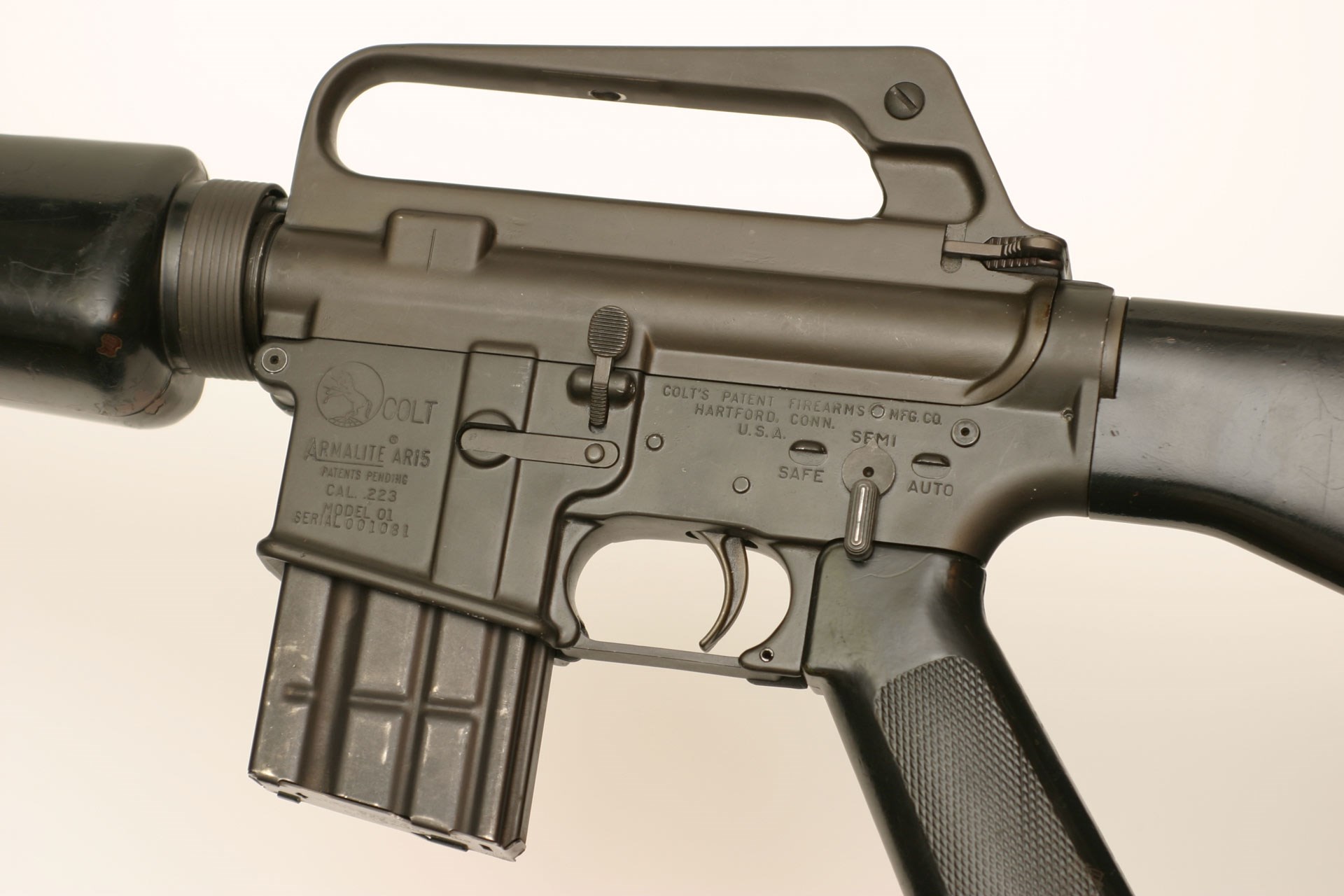 Left
side closeup of Colt/ArmaLite Model 601 Serial No. 001081. The rifle’s
original green painted furniture has been replaced by black painted
furniture. Photo by the author
Left
side closeup of Colt/ArmaLite Model 601 Serial No. 001081. The rifle’s
original green painted furniture has been replaced by black painted
furniture. Photo by the author
As the latest batch of modified prototype AR-15s was being built back in Hollywood, Calif., later that year, ArmaLite was in trouble. The company was losing money and was therefore in no position to continue the costly design development of the AR-15, even though it was beginning to look like the Army just might adopt the rifle. While a multi-million-dollar government contract could save the day, there was another even bigger problem that had to be addressed. ArmaLite was a small shop that was not capable of the kind of mass production that would be required if the Army placed a big order, and Fairchild’s Board of Directors was not willing to allow it to establish an in-house production line.
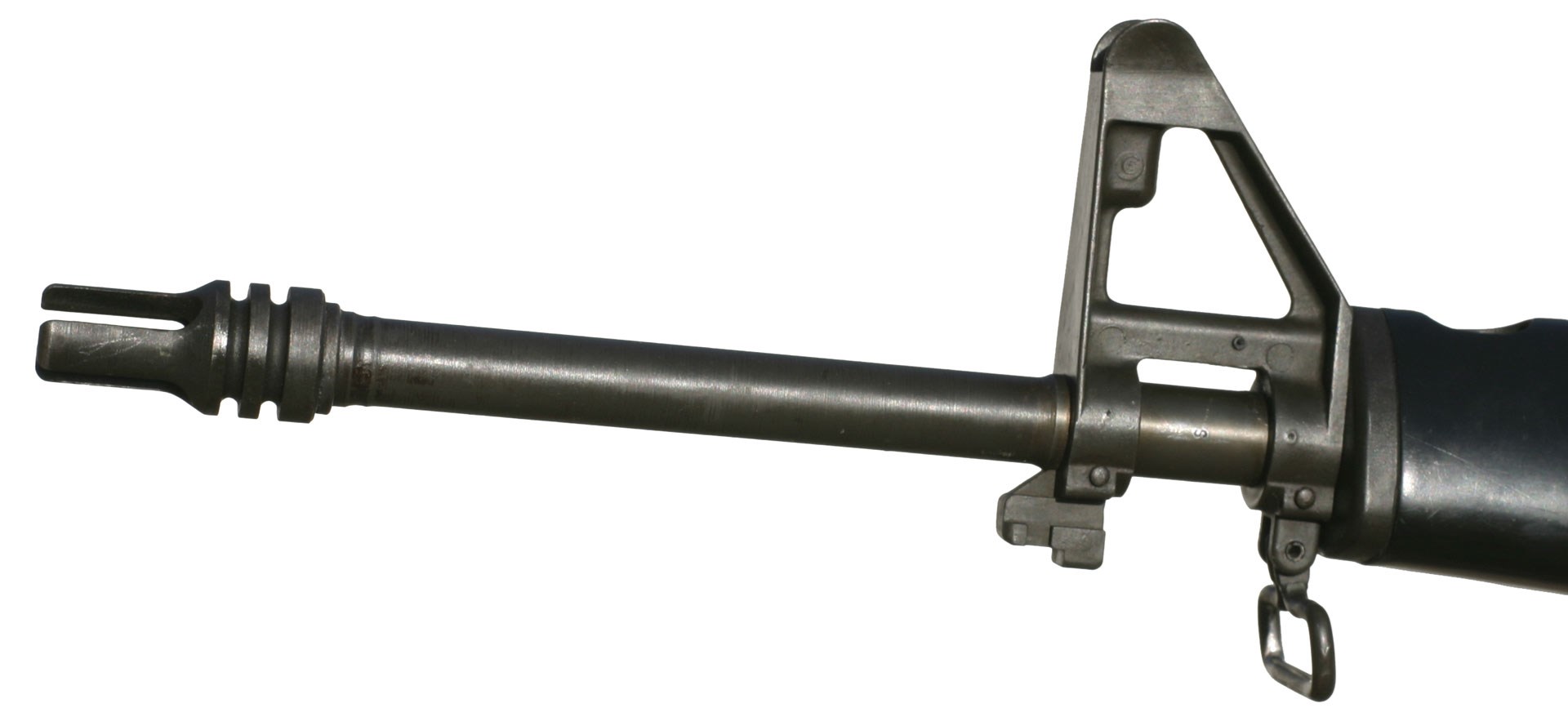 Closeup of the cast front sight base and duckbill flash suppressor of Colt/ArmaLite Model 601 Serial No. 001081. Photo by the author
Closeup of the cast front sight base and duckbill flash suppressor of Colt/ArmaLite Model 601 Serial No. 001081. Photo by the author
ArmaLite was going to need a well-resourced partner capable of financing the AR-15’s continuing design development and eventually the large-scale production of the rifle. Colt’s Patent Firearms turned out to be that partner. Although it was not much better off than Fairchild or ArmaLite financially, Colt nevertheless had the kind of industrial capacity to get large scale production of the AR-15 rolling. To that end, the company bought the rights to the AR-15 from ArmaLite in 1959 for a lump sum of $75,000, plus a 4.5-percent royalty against future sales for the use of Eugene Stoner’s patented gas system.
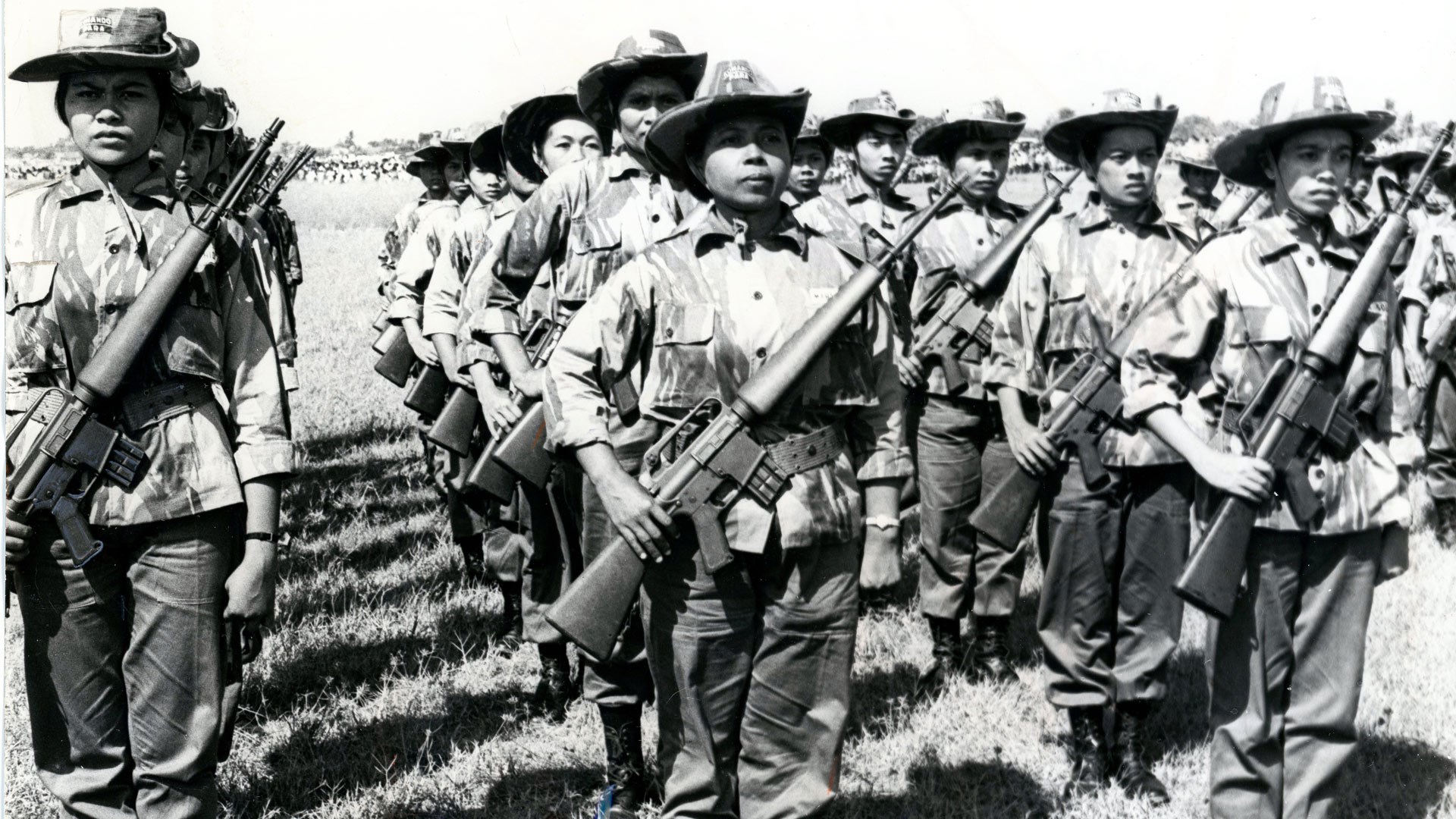 Indonesian female volunteer paratroopers armed with Colt/ArmaLite AR-15 Model 601 rifles - June 1965. Author’s collection
Indonesian female volunteer paratroopers armed with Colt/ArmaLite AR-15 Model 601 rifles - June 1965. Author’s collection
Just when it looked like the future of the AR-15 was in good shape, the Army backed away from it. The rifle had failed rain tests, and it did not help matters at all that Arctic testing in Alaska left a false indication that there were more problems yet to be solved. At that point the gun had progressed through enough of a design evolution that it was ready for mass production, and when that began at Colt in December 1959, it was assigned the model number “01,” the first of many in Colt’s “600 series” of AR-15 type rifles. But even as serial production of the Model 601 began in Connecticut, the gun’s evolution continued. After assembling the first 300 rifles with unpainted Bakelite handguards, pistol grips and buttstocks, Colt began applying a light green epoxy paint to the furniture. Toward the end of Model 601 production though, black paint replaced green.
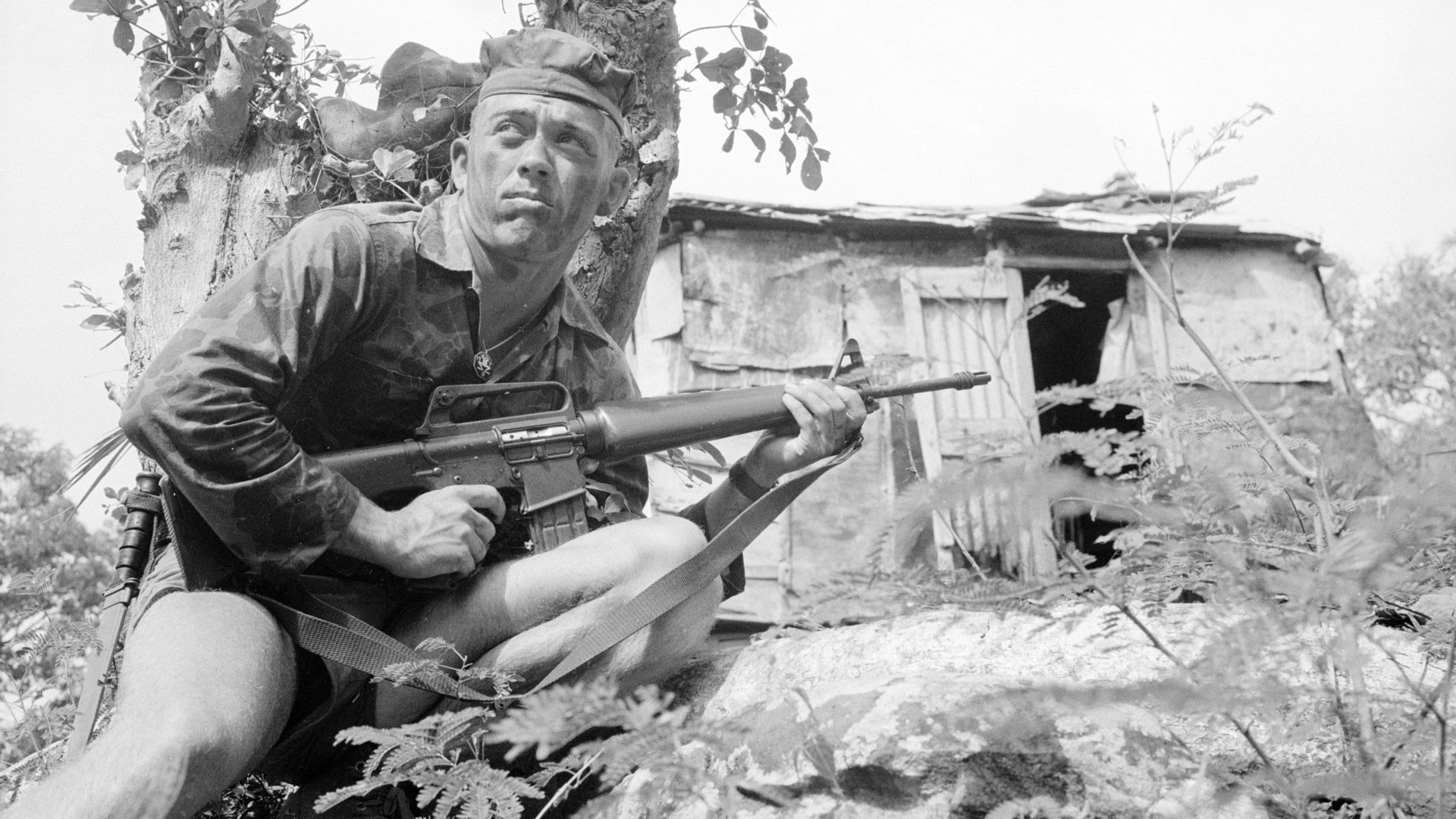 A
U.S. Navy SEAL armed with a Colt/ArmaLite Model 601 is seen here during
a training exercise on St. Thomas, U.S. Virgin Islands on February 21,
1963. Photo by Marion S. Trikosko/US News and World Report Collection/PhotoQuest/Getty Images
A
U.S. Navy SEAL armed with a Colt/ArmaLite Model 601 is seen here during
a training exercise on St. Thomas, U.S. Virgin Islands on February 21,
1963. Photo by Marion S. Trikosko/US News and World Report Collection/PhotoQuest/Getty Images
Eventually, changes were also made to the profile of the buttstock, the configuration of the receiver roll markings and the type of aluminum alloy used to make the uppers and lowers. By the 1960s though, the Model 601 had reached its final form right at about the time that things really began to happen for it. On July 4, 1960, the U.S. Air Force Vice Chief of Staff, Gen. Curtis LeMay, test fired Model 601 Serial No. 000106 during a barbeque in Maryland, and the emphatically positive impression he took away from the experience would ultimately lead to the rifle’s adoption by the American military. Although the U.S. Army had initiated the development evolution that eventually led to the creation of the Model 601, it was the U.S. Air Force that made the first purchase, and that set in motion the sequence of events that brought a Model 601 to the White House on April 19, 1963.
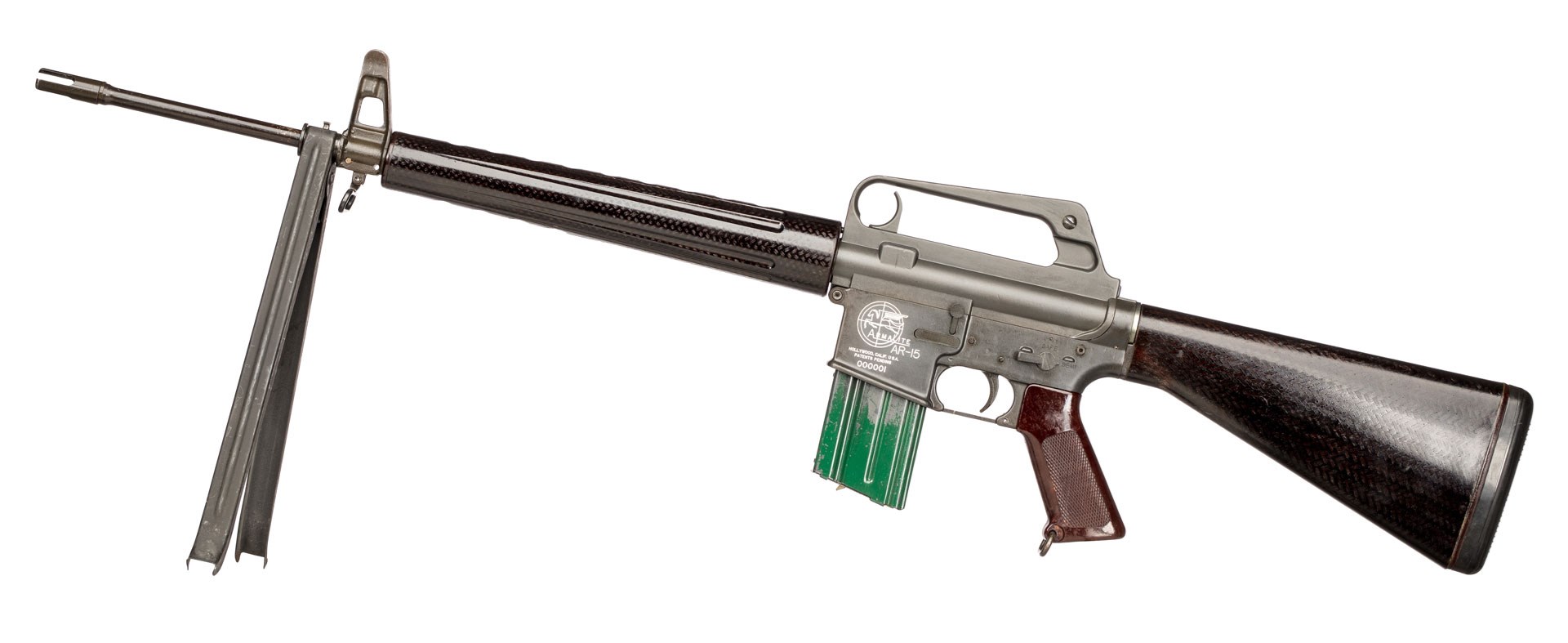 Left side view of ArmaLite prototype AR-15 Serial No. 000001 with bipod attached. Photo courtesy of the Institute for Military Technology
Left side view of ArmaLite prototype AR-15 Serial No. 000001 with bipod attached. Photo courtesy of the Institute for Military Technology
The AR-15 that JFK handled that day had come a long way from the XAR-1501 that had started it all way back in 1957, and many big changes were yet to come. But, in those days before forward assist devices, birdcage flash suppressors, chrome-lining, flat top upper receivers and three-round burst, the rifle was lighter, simpler and more lethal. In the end, the AR-15 would be asked to do much more than anyone could have imagined in 1963, and it would serve all the way across the threshold of the 21st century. President Kennedy would not live to see any of this though because the example he inspected in the Oval Office that Friday afternoon in April 1963 was the only AR-15 he would ever know.
It has truly been a LONG and winding road!
ReplyDeleteI had one of the A.I. AR-10's. The goal was to have a 1000 meter rifle. I never got a load that was consistent. After messing with the gun for about 5 years I sold it for a slight profit. The best I could do was 550 yards to get all rounds of a magazine in a 12" circle. I can do better than that with my 6.8SPC on an AR-15 platform. I will stick with my bolt action 30-06 for the 1000 meter shot but I only have 4 shots before I have to reload.
ReplyDelete